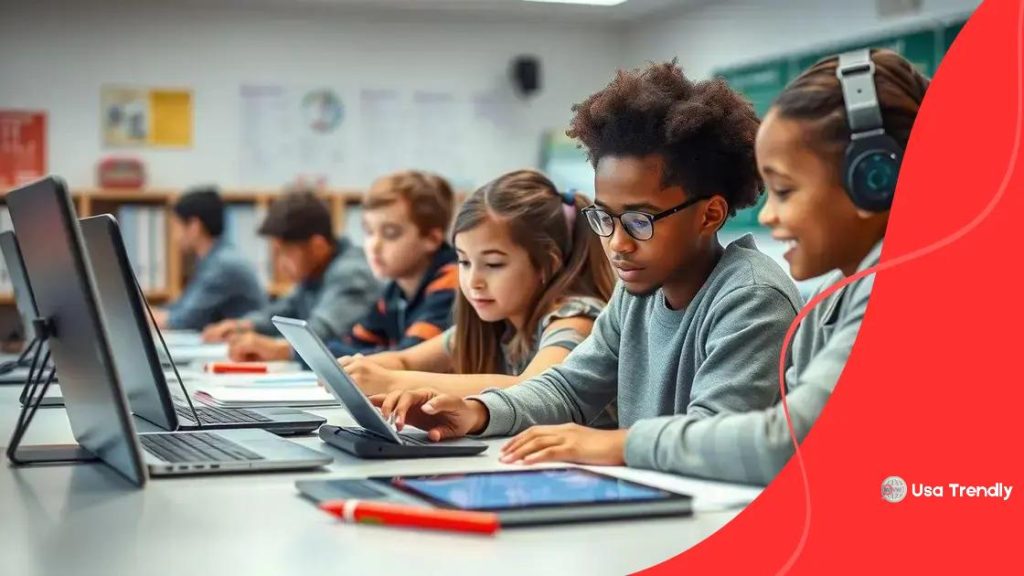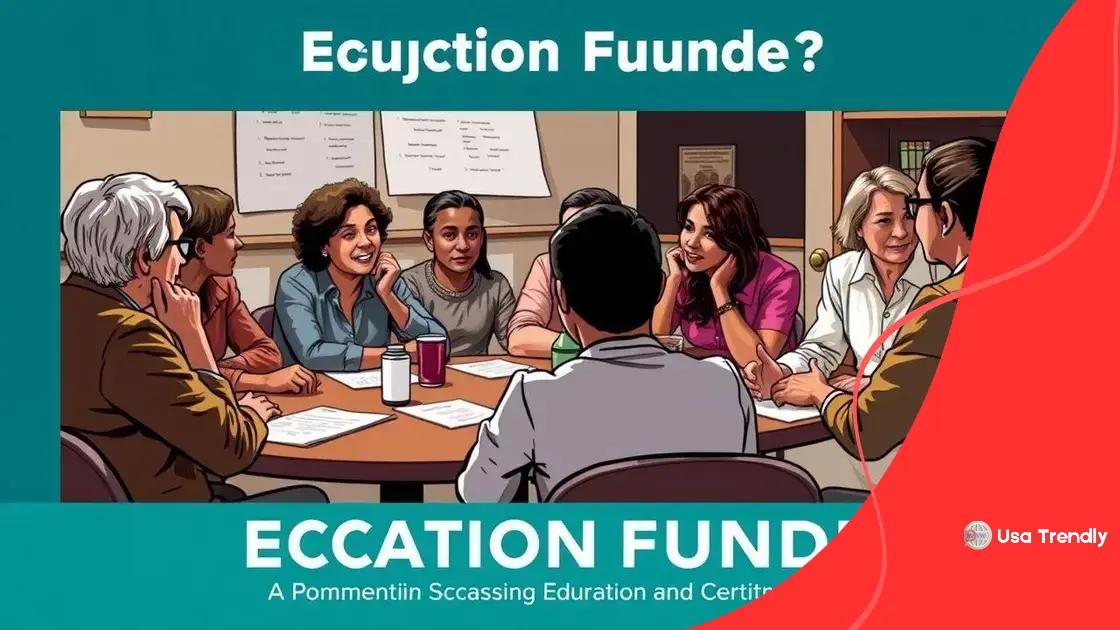Education policy reforms proposed by administration

Education policy reforms focus on improving student outcomes, fostering innovative teaching methods, and ensuring equity in education through collaboration among educators, parents, and the community.
Education policy reforms proposed by administration are crucial for shaping the future of our learning systems. Have you ever wondered how these changes might impact your local schools and your child’s education?
Overview of proposed reforms
The overview of proposed reforms is essential for understanding the direction our education system is heading. It encapsulates the key changes that can reshape the learning environment.
Key Areas of Focus
These reforms target several critical aspects of education:
- Curriculum updates to reflect modern needs
- Increased funding for under-resourced schools
- Enhanced teacher training programs
- Integration of technology in classrooms
Moreover, the proposed reforms aim to tackle issues like educational equity. Addressing disparities in funding means all students, regardless of their background, deserve a high-quality education. These changes encourage innovative teaching practices that can engage students more effectively.
Expected Outcomes
With these reforms, we expect to see substantial improvements in student outcomes. Metrics such as graduation rates and standardized test scores are key indicators of success. By focusing on personalized learning and inclusive practices, we can create a more supportive learning atmosphere for every student.
In summary, the overview of proposed reforms highlights the importance of transforming education into a more equitable system. The collective efforts by educators, policymakers, and communities are vital in implementing changes that support all learners.
Impact on teachers and students
The impact on teachers and students is significant when discussing education policy reforms. These changes not only influence the curriculum but also shape the classroom environment.
Effects on Teachers
Teachers are at the forefront of implementing these reforms. One major change includes increased support and resources. This can lead to enhanced professional development opportunities, allowing educators to refine their skills and adapt to new teaching methods.
- Professional training programs to improve instruction
- Access to modern teaching tools and materials
- Support networks for collaboration and sharing best practices
Moreover, with a focus on teacher well-being, reforms may help create a more satisfying work environment. This can reduce burnout and improve job satisfaction, which ultimately benefits students.
Effects on Students
For students, the proposed reforms represent a shift towards more personalized learning experiences. This means they may receive tailored instruction that meets their unique needs and learning styles. Engaging students with relevant material enhances their motivation and participation.
Furthermore, reforms can increase access to advanced technology. This helps bridge the gap in digital literacy skills, preparing students for the future workforce. The impact of these changes can be transformational, enabling students to thrive academically and socially.
Ultimately, a positive environment fostered by supportive policies can lead to higher student engagement and success. The impact on teachers and students highlights the interconnectedness of educational reform and its broader implications for society.
Funding sources for education reforms

Understanding the funding sources for education reforms is crucial for the successful implementation of proposed changes. Different avenues exist to secure necessary financial support, ensuring that reforms become reality.
Government Funding
One of the primary sources of funding is government budgets. Federal, state, and local governments allocate funds specifically for education. These budgets can provide essential resources to support new initiatives.
- Federal grants that target specific reforms
- State-level funding for local school districts
- Initiatives aimed at reducing disparities in education
By increasing these allocations, governments can help schools adopt innovative strategies that enhance learning experiences for all students.
Private Sector Contributions
The private sector also plays a significant role in funding education reforms. Corporations and philanthropists often invest in schools to improve educational outcomes. Partnerships between schools and businesses can lead to exciting opportunities.
- Corporate sponsorships for educational programs
- Donations from foundations focused on educational equity
- Investments in technology and infrastructure
These contributions can bridge the gap where public funding may fall short, providing additional resources to enhance the learning environment.
In addition to government and private funding, community involvement is another valuable resource. Local communities can mobilize support for education through fundraising events, volunteer efforts, and advocacy for increased school budgets. Together, these combined efforts highlight the importance of collaboration in securing the necessary resources for successful education reforms.
Challenges of implementing changes
The challenges of implementing changes in education policy are significant and complex. While the proposed reforms aim for improvement, various obstacles can hinder their effectiveness.
Resistance to Change
One major challenge is resistance from different stakeholders. Many educators and administrators may be hesitant to adopt new methods. This can stem from a lack of training or fear of the unknown.
- Concerns about disrupting established practices
- Limited resources to support new initiatives
- Fear of accountability linked to new standards
These factors can create a barrier, making it difficult to engage staff and garner support for new changes.
Limited Funding
Another significant obstacle is the availability of funding. Even with strong proposals, if financial resources are lacking, implementing reforms becomes challenging. Budget cuts or reallocations can lead to insufficient support.
Additionally, there may be competing priorities within the education system that can divert funds away from necessary reforms. Financial constraints can limit access to training, technology, and materials needed for successful implementation.
Moreover, the timeline for changes can be an issue. Rapid shifts can overwhelm teachers and students, making it essential to have a strategic plan that allows for gradual adaptation. Balancing urgency with feasibility is key to overcoming these challenges.
In conclusion, addressing and understanding the challenges of implementing changes is vital for the success of education policy reforms. It requires collaboration and a commitment to adapting strategies based on feedback from all parties involved.
Future of education policy
The future of education policy is an exciting topic filled with possibilities. As society evolves, so do the needs of students and educators. Embracing this change is vital for developing effective policies.
Innovative Teaching Methods
One trend shaping the future is the adoption of innovative teaching methods. Educators are increasingly using technology to enhance learning. This includes tools like virtual reality, gamification, and personalized learning experiences.
- Integration of artificial intelligence for personalized curriculums
- Blended learning environments combining in-person and online education
- Project-based learning that encourages critical thinking
These approaches can make education more engaging and relevant for students.
Policy Adaptability
Future education policies will also need to be adaptable. As new challenges arise, policymakers must be ready to adjust strategies quickly. This adaptability ensures that reforms remain effective and responsive to student needs.
Collaboration among stakeholders will be crucial. Schools, parents, and community members should work together to create policies that support student success. Engaging all voices in the conversation can lead to more comprehensive solutions.
The future will likely focus on equity and inclusion as well. Ensuring access to quality education for all students, regardless of their background, is a priority. This commitment helps close the achievement gap and promotes a diverse learning environment.
In essence, the future of education policy holds great promise. By embracing innovation and collaboration, we can create a robust education system that prepares students for the challenges of tomorrow.
FAQ – Frequently Asked Questions about Education Policy Reforms
What are the main goals of education policy reforms?
The main goals include improving student outcomes, increasing equity in education, and fostering innovative teaching methods.
How can technology improve learning environments?
Technology can enhance engagement through tools like virtual classrooms, personalized learning apps, and interactive resources that cater to different learning styles.
What role do teachers play in implementing these reforms?
Teachers are crucial as they adapt and apply new methods in the classroom, providing feedback that shapes ongoing improvements to the reforms.
How can parents and the community support education reforms?
Parents and community members can engage by advocating for funding, participating in school activities, and collaborating with educators to create supportive learning environments.
SEE MORE CONTENT